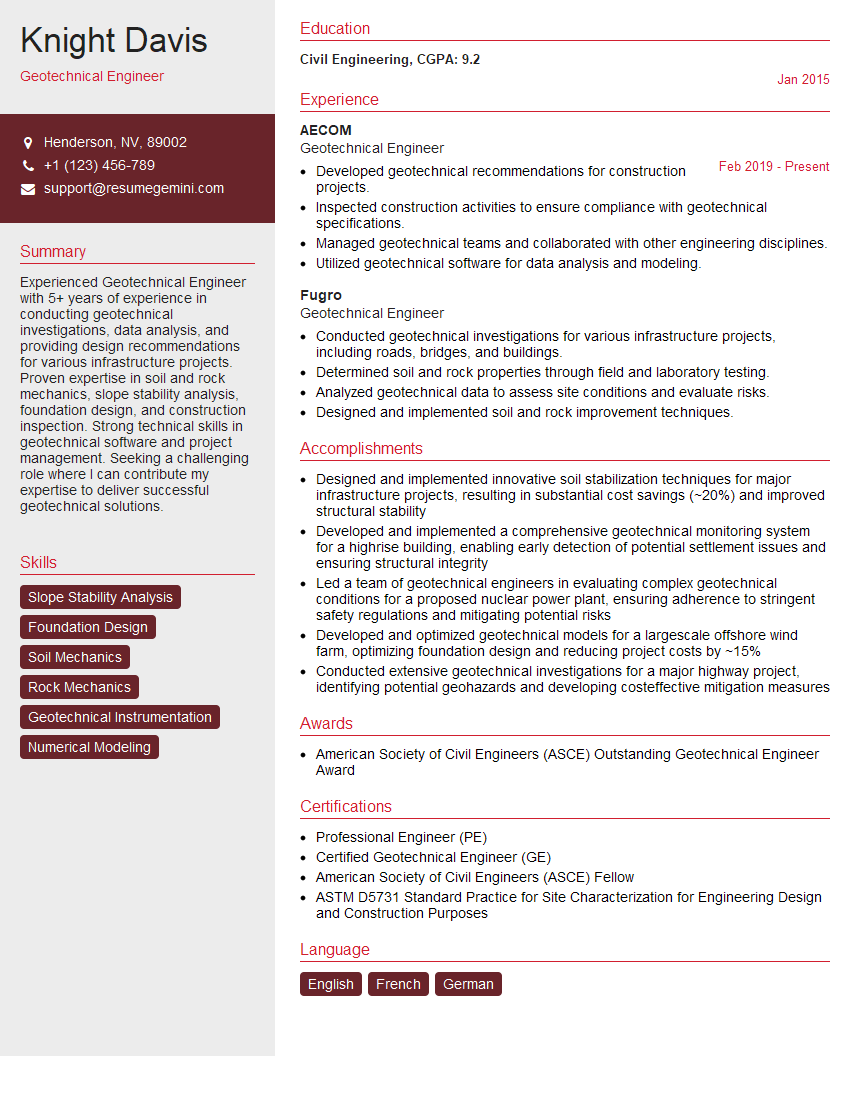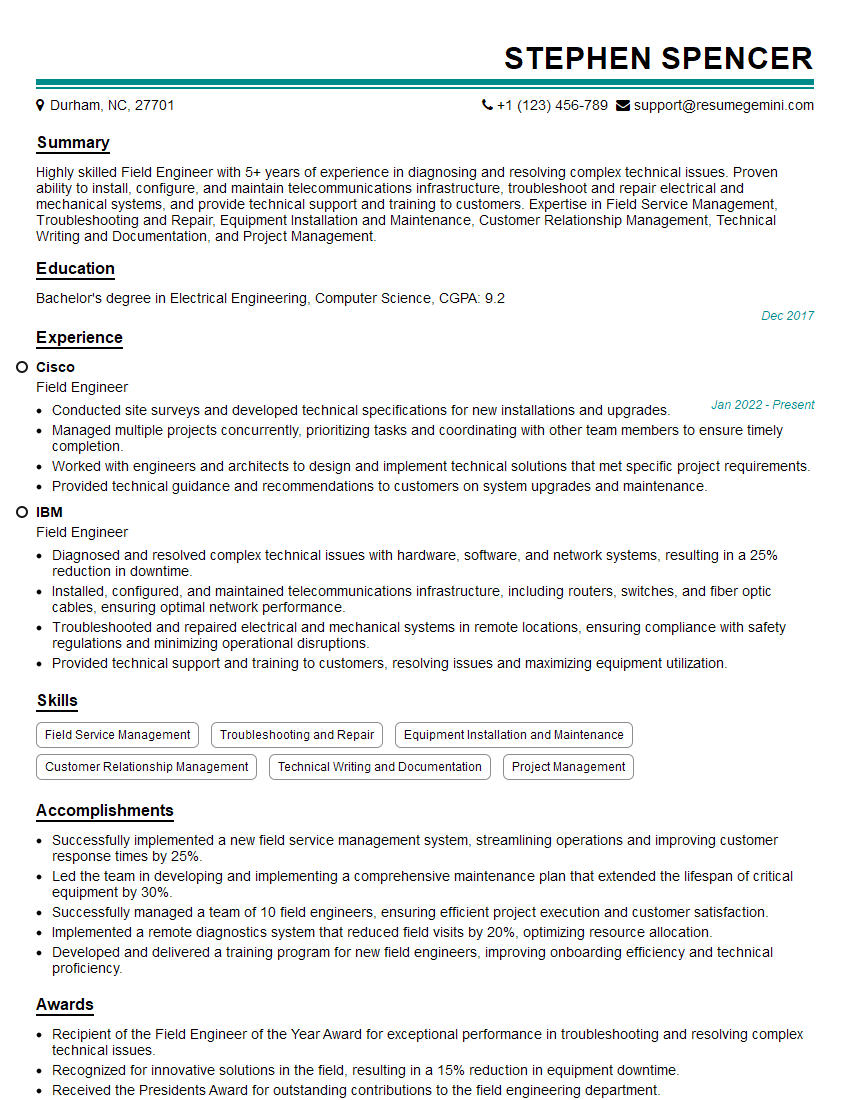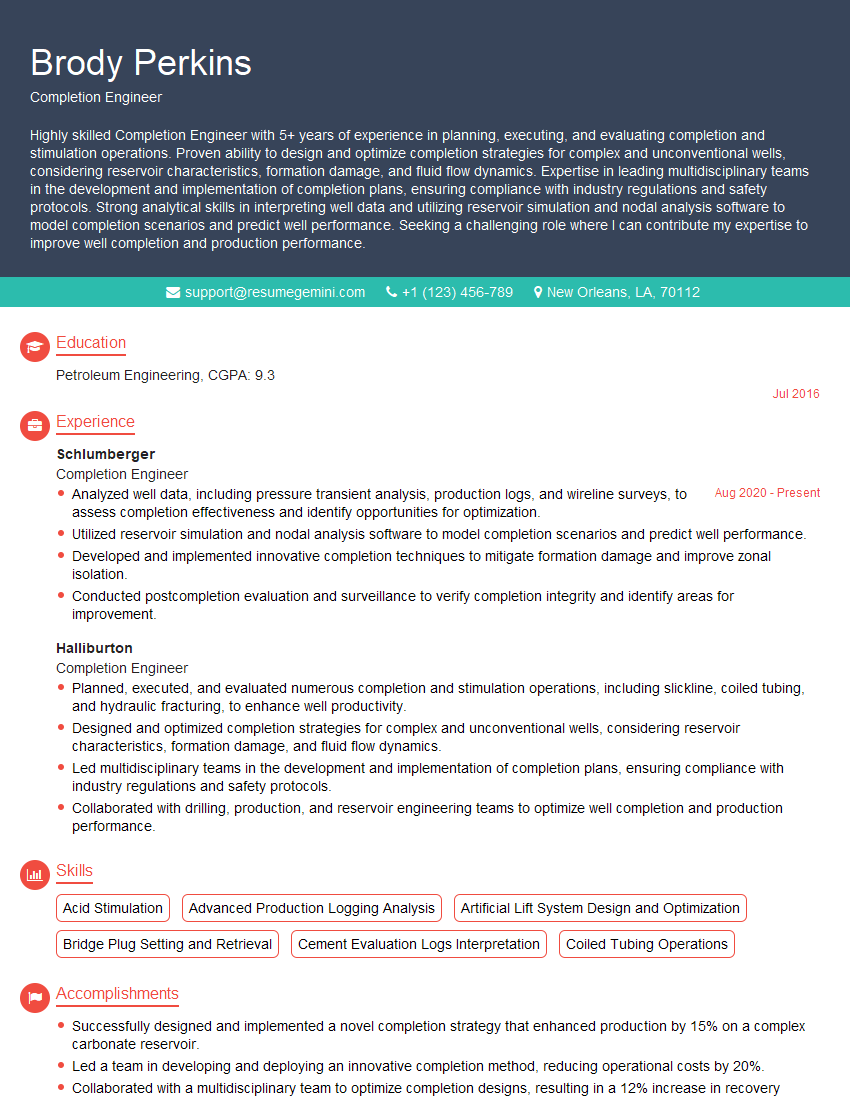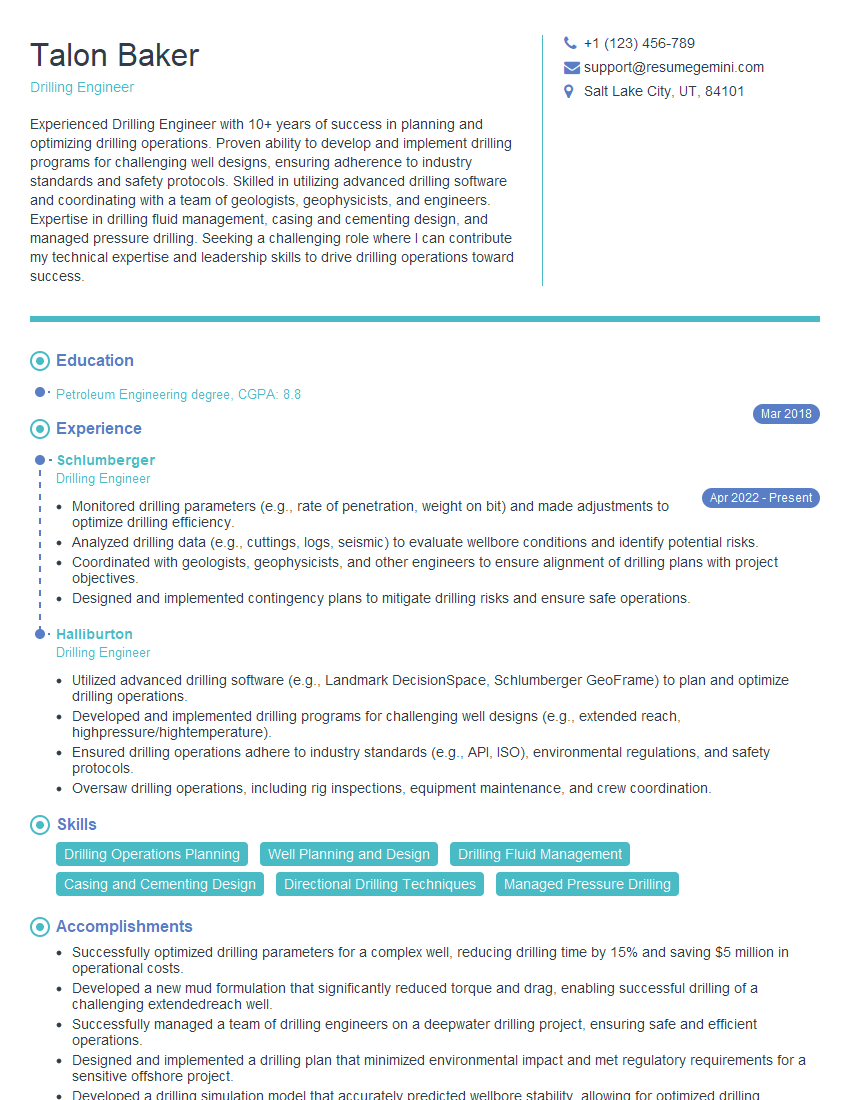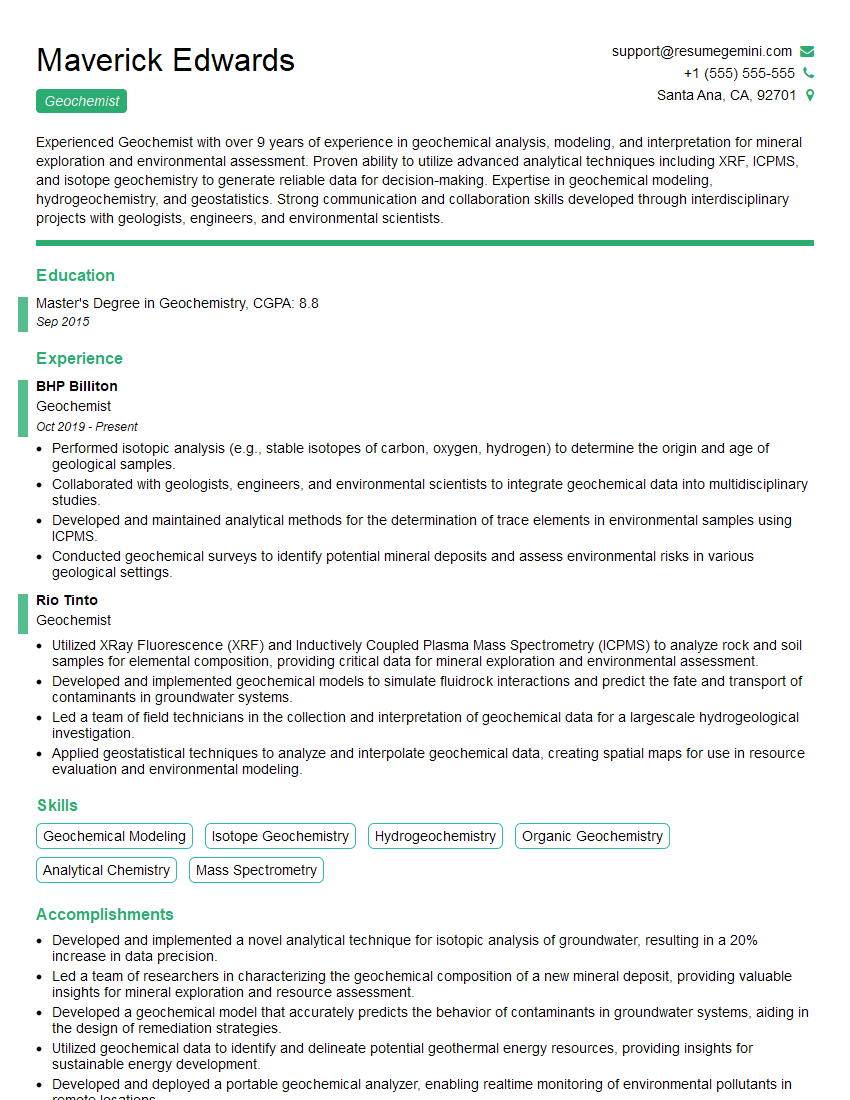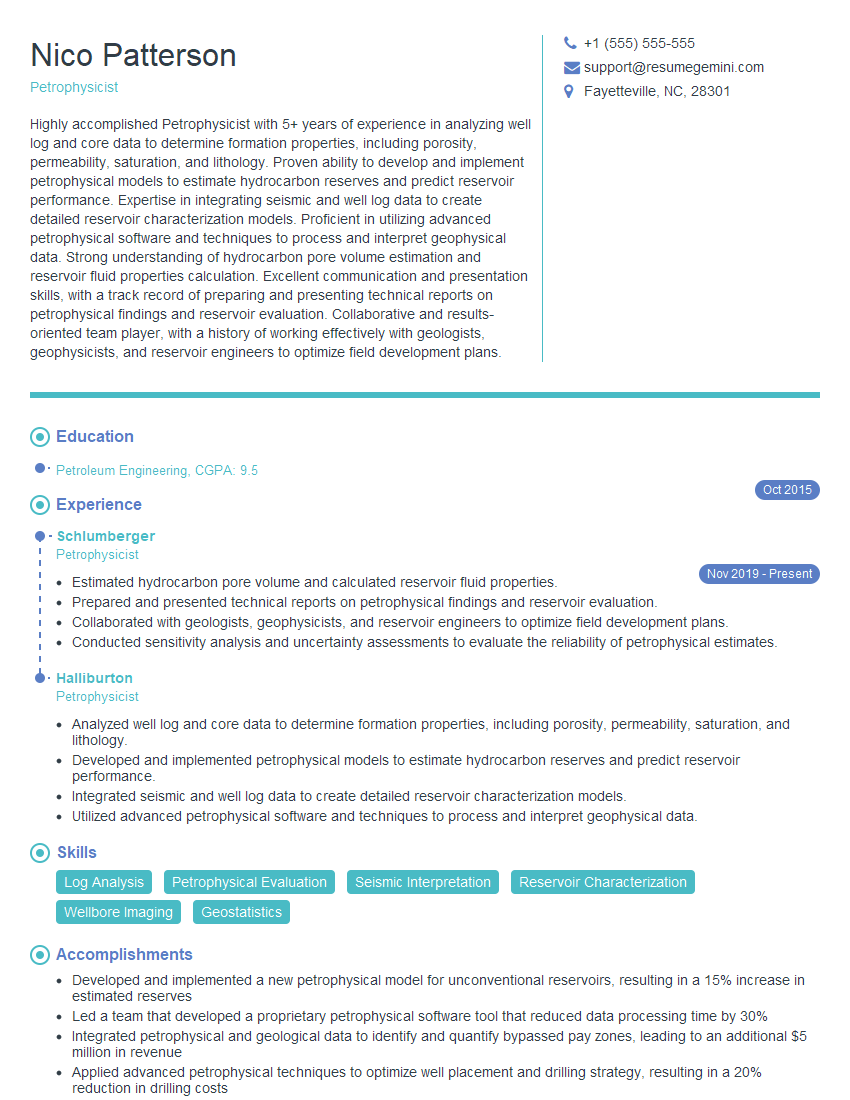The thought of an interview can be nerve-wracking, but the right preparation can make all the difference. Explore this comprehensive guide to Mud Gas Analysis interview questions and gain the confidence you need to showcase your abilities and secure the role.
Questions Asked in Mud Gas Analysis Interview
Q 1. Describe the process of collecting and analyzing mud gas samples.
Mud gas analysis begins with the careful collection of gas samples from the drilling mud. This mud, a crucial part of the drilling process, circulates down the wellbore, carrying with it any gas that migrates from the formations being drilled. Several methods exist for collecting the gas. One common method involves using a degasser, a device that separates the gas from the mud under controlled conditions. The gas is then collected in a sample container, often a sealed bag or cylinder, ensuring minimal contamination. Another method utilizes specialized mud gas analyzers that are directly connected to the mud stream, providing continuous monitoring of gas composition.
Once collected, the sample undergoes analysis. This involves using a gas chromatograph (GC), a sophisticated instrument that separates the various components of the gas mixture based on their physical properties. The GC then quantifies each component, providing a precise measurement of its concentration within the sample. This data is typically expressed as a percentage of the total gas volume or as parts per million (ppm) for trace gases. Proper procedures for sample handling and analysis are critical to ensure the accuracy and reliability of the results. For example, contamination from atmospheric gases must be avoided throughout the entire process.
Q 2. Explain the significance of methane, ethane, and propane in mud gas analysis.
Methane (CH4), ethane (C2H6), and propane (C3H8) are crucial indicators in mud gas analysis. They are the lightest hydrocarbons commonly found and their relative concentrations offer valuable information about the formations being drilled. Methane is usually the most abundant hydrocarbon in mud gas. High methane concentrations can indicate the presence of shallower, less mature hydrocarbon reservoirs or biogenic gas sources.
Ethane and propane, being heavier hydrocarbons, are more indicative of deeper, more mature hydrocarbon reservoirs. Their presence, especially in higher concentrations relative to methane, suggests a greater likelihood of encountering significant oil or gas accumulations. The ratio of these gases (e.g., ethane/methane ratio) helps geologists assess the maturity and type of hydrocarbon source rock. A high C2/C1 ratio (ethane to methane ratio) can suggest oil-prone source rocks, while a low ratio often suggests gas-prone rocks. This is because oil-prone sources tend to generate more heavier hydrocarbons during their thermal maturation process.
Q 3. How do you identify and interpret gas anomalies in mud gas data?
Identifying gas anomalies relies on comparing real-time mud gas data to baseline data established earlier in the drilling process. Any significant deviation from the baseline – a sudden increase or decrease in the concentration of specific gases, or changes in the gas ratios – is considered an anomaly. For example, a sudden surge in methane concentration might indicate a potential gas kick, which needs immediate action to prevent a well control incident.
Interpretation of these anomalies requires careful consideration of several factors, including drilling depth, formation type, and the overall geological context. Software tools and experienced mud gas engineers play a critical role in analyzing data trends and interpreting potential causes for these changes. It’s crucial to understand that not all gas anomalies signify a problem. Natural variations in formation permeability and gas composition can also lead to fluctuations in mud gas concentrations.
Q 4. What are the limitations of mud gas analysis?
Mud gas analysis, while invaluable, has limitations. The most significant limitation is that the gas detected may not be representative of the reservoir’s true composition. The mud circulation system can dilute or alter gas concentrations, potentially masking the actual reservoir properties. Furthermore, the process is indirect; we infer reservoir characteristics from gas escaping into the mud. Also, the analysis focuses primarily on lighter hydrocarbons. Heavier hydrocarbons and other volatile compounds may not be effectively detected or analyzed using standard methods. The depth of the reservoir and the quality of the drilling mud can also affect the accuracy of the measurements.
Q 5. How does mud gas analysis contribute to wellsite safety?
Mud gas analysis is a vital tool for enhancing wellsite safety. Its primary contribution lies in the early detection of gas kicks – the influx of formation gas into the wellbore. A sudden increase in mud gas concentrations, especially methane, is a primary warning sign of a potential kick. Early detection allows for timely implementation of well control procedures, preventing potentially catastrophic blowouts and other well control incidents. By continuously monitoring gas concentrations, the mud gas system helps mitigate risks associated with gas migration and keeps the personnel on site safe.
Q 6. Explain the relationship between mud gas composition and formation pressure.
The composition of mud gas can provide valuable insights into formation pressure. While not a direct measurement, the presence and concentration of gas, particularly lighter hydrocarbons like methane, are often associated with higher pore pressures in the formation. This is because gas expands and can exert significant pressure. A rapid increase in the concentration of light gases can signal abnormally high formation pressure and potential over-pressured formations. Experienced engineers often use empirical correlations and geological models, incorporating mud gas data alongside other parameters such as drilling rate and mud weight to estimate formation pressures. It is important to note this isn’t a stand-alone method but rather contributes to a larger suite of information used for pressure prediction.
Q 7. Describe the different types of gas detectors used in mud gas analysis.
Various gas detectors are used in mud gas analysis, ranging from simple portable detectors to sophisticated automated systems. Simple flame ionization detectors (FID) are used to measure the total hydrocarbon content. More advanced gas chromatographs (GC) offer detailed compositional analysis, separating and quantifying individual gas components like methane, ethane, propane, and others. Mass spectrometers can also provide detailed compositional analysis. The choice of detector depends on factors such as the level of accuracy required, the types of gases being monitored, and cost considerations. Some modern systems also include data acquisition software for automated data logging and real-time analysis, improving efficiency and providing instant alerts for significant deviations.
Q 8. How do you calibrate gas detection equipment?
Calibrating gas detection equipment is crucial for ensuring accurate and reliable measurements. The process involves using calibrated gas standards of known concentrations to adjust the instrument’s readings. This is usually done using a multi-point calibration, meaning we use several gas standards spanning the instrument’s measurement range. For instance, a methane detector might be calibrated using standards of 0%, 25%, 50%, and 100% methane in air.
The calibration procedure typically involves introducing each gas standard into the instrument’s sensor, allowing it to stabilize, and then adjusting the instrument’s response to match the known concentration. This involves using the instrument’s built-in calibration routines, which can vary depending on the manufacturer and model. Detailed instructions are always provided in the instrument’s manual. Calibration certificates must be maintained and readily available to demonstrate the instrument’s accuracy and compliance with safety regulations. Regular calibration, often daily or weekly depending on usage and regulations, is essential to maintain the accuracy of the readings.
Failing to properly calibrate the equipment leads to inaccurate readings, potentially resulting in misinterpretations of mud gas data and jeopardizing safety.
Q 9. What are the safety procedures for handling mud gas samples?
Safety when handling mud gas samples is paramount. Mud gas is often composed of flammable and toxic components like methane, hydrogen sulfide, and carbon dioxide. Therefore, all procedures must adhere to strict safety protocols. This includes working in a well-ventilated area, wearing appropriate personal protective equipment (PPE), which minimally includes safety glasses, gloves, and a respirator appropriate for the anticipated gas composition.
Samples should be collected and transferred using appropriate procedures to prevent leakage and exposure. This often involves using sealed containers designed for gas sampling. Before opening any container, it’s crucial to check for leaks and ensure proper ventilation. Gas detection equipment should be used to monitor the surrounding atmosphere for hazardous gas levels before and during sample handling. If high levels of flammable or toxic gases are detected, work must immediately cease, and the area must be ventilated until safe levels are reached.
Furthermore, a thorough risk assessment must be conducted prior to sampling and handling. Emergency response plans, including access to emergency showers and eyewash stations, should be in place and all personnel involved should receive adequate safety training.
Q 10. How do you ensure the accuracy and reliability of mud gas data?
Ensuring accurate and reliable mud gas data requires a multi-faceted approach. It starts with proper calibration of the gas detection equipment, as discussed earlier. Beyond calibration, the sampling procedure itself plays a significant role. This involves using appropriate sampling techniques to minimize contamination and obtain a representative sample of the mud gas. For example, ensuring the sample line is purged properly before collecting the sample prevents erroneous results due to residual gas from previous samples.
Data processing and analysis must also be meticulous. This includes using validated analytical methods and accounting for potential sources of error such as sample contamination or instrument drift. Using quality control checks, including replicate samples and blank samples, helps identify potential issues. Regular maintenance and calibration of the analytical equipment is crucial. Documentation of all procedures, including sampling, analysis, and calibration, is essential for traceability and quality assurance.
Finally, using established industry standards and best practices ensures data reliability. A well-defined quality control/quality assurance (QC/QA) program is crucial to guaranteeing data integrity.
Q 11. Explain the impact of drilling parameters on mud gas composition.
Drilling parameters significantly influence mud gas composition. For instance, changes in the rate of penetration (ROP) can affect the amount of formation gas entering the mud system. A high ROP might lead to a more rapid influx of gas, potentially increasing the concentration of certain components in the mud gas.
Mud weight also plays a role. A heavier mud column exerts greater pressure on the formation, potentially reducing the amount of gas entering the mud. The type of drilling fluid used can also influence gas solubility. Some mud formulations might have a higher capacity to dissolve certain gases, leading to lower gas concentrations in the mud system.
The type of formation being drilled also influences gas composition. Different geological formations contain different types and concentrations of gases. Finally, wellbore conditions, such as the pressure and temperature, influence the behavior of the gases within the wellbore, which can in turn alter the gas composition found in the mud system.
Q 12. How do you interpret mud gas data in the context of formation evaluation?
Interpreting mud gas data in the context of formation evaluation is a crucial step in hydrocarbon exploration. The presence and concentration of specific gases, such as methane, ethane, propane, and heavier hydrocarbons, provide valuable insights into the type and potential presence of hydrocarbons in the formation. For example, a high concentration of methane might indicate a gas-bearing formation, while a higher proportion of heavier hydrocarbons could suggest an oil-bearing formation.
The presence of gases like hydrogen sulfide (H2S) or carbon dioxide (CO2) indicates the presence of these gases in the reservoir, which have safety and operational implications. Changes in gas concentrations over time can indicate the proximity to hydrocarbon reservoirs or changes in the formation being drilled. Data is often analyzed alongside other data such as pressure and temperature readings to create a complete picture of the reservoir characteristics.
Experienced mud gas analysts interpret this information in conjunction with geological data to construct a comprehensive reservoir model, predicting the potential hydrocarbon resources and assisting in decision making throughout the drilling process.
Q 13. What are the potential sources of error in mud gas analysis?
Several potential sources of error can affect the accuracy of mud gas analysis. These include:
- Sampling errors: Improper sampling techniques, such as inadequate purging of the sampling line, can lead to contamination and inaccurate results. Leaks in the sampling system can also alter the gas composition.
- Analytical errors: Instrument malfunction, inaccurate calibration, or operator error can compromise the accuracy of gas concentration measurements.
- Contamination: Contamination from the drilling mud, surface gases, or atmospheric air can significantly influence the gas composition of the sample.
- Gas solubility: The solubility of gases in the drilling mud can vary depending on pressure, temperature, and mud composition, impacting the gas concentrations measured.
- Data handling errors: Transcription errors, miscalculation during data analysis, and incorrect data interpretation can also affect accuracy.
Careful attention to detail in all stages of the process from sample collection to data analysis is crucial to minimize these errors.
Q 14. How do you handle data inconsistencies in mud gas analysis?
Handling data inconsistencies in mud gas analysis requires a systematic approach. The first step is to identify the source of the inconsistency. This may involve reviewing the sampling procedures, analyzing the analytical data for potential errors, and checking the calibration records of the instrument used.
If the inconsistency is due to a clear sampling error (e.g., a known leak in the sampling line), the data point in question may be discarded. If the source is less clear, replicate analyses may be performed to determine if the data is repeatable. Data that consistently shows inconsistencies after repeated attempts may be flagged, but not necessarily discarded. All inconsistencies must be documented. If inconsistencies appear to be a systematic error, this may suggest issues with the equipment calibration or sampling procedures, highlighting the need for recalibration or procedural improvement.
Statistical analysis techniques, such as outlier detection methods, can be used to identify and handle inconsistencies. In all cases, the detailed documentation is vital for transparency and accurate reporting.
Q 15. Describe the use of mud gas analysis in identifying potential hydrocarbon reservoirs.
Mud gas analysis is a crucial technique in the oil and gas industry used to detect the presence of hydrocarbons during drilling operations. Essentially, we analyze the gases that are released from the wellbore and dissolved in the drilling mud. The composition of this gas provides valuable clues about the subsurface formations we’re drilling through. Increased concentrations of light hydrocarbons like methane, ethane, and propane, compared to background levels, often indicate proximity to a hydrocarbon reservoir. This is because these gases are naturally associated with petroleum deposits and tend to migrate upwards. The presence of heavier hydrocarbons provides further indications about the type and quality of the reservoir.
For example, a sudden increase in methane concentration might signal the entry into a gas reservoir. Similarly, a higher ratio of propane to methane can be indicative of an oil reservoir. We use sophisticated analytical methods to differentiate between background gas and that emanating from a potential hydrocarbon reservoir.
Career Expert Tips:
- Ace those interviews! Prepare effectively by reviewing the Top 50 Most Common Interview Questions on ResumeGemini.
- Navigate your job search with confidence! Explore a wide range of Career Tips on ResumeGemini. Learn about common challenges and recommendations to overcome them.
- Craft the perfect resume! Master the Art of Resume Writing with ResumeGemini’s guide. Showcase your unique qualifications and achievements effectively.
- Don’t miss out on holiday savings! Build your dream resume with ResumeGemini’s ATS optimized templates.
Q 16. How does mud gas analysis assist in preventing well control incidents?
Mud gas analysis plays a vital role in preventing well control incidents, such as kicks (influx of formation fluids into the wellbore) and blowouts. By continuously monitoring the gas composition, we can detect early warning signs of an impending influx of formation fluids. A sudden increase in gas pressure or the appearance of heavier hydrocarbons in the mud gas, for example, indicates a potential kick. This early detection allows for immediate action, such as reducing the drilling rate, increasing the mud weight, and implementing other well control procedures, thereby mitigating the risk of a well control incident.
Imagine a scenario where we detect a gradual increase in methane and ethane concentrations. This might not immediately signal a critical event, but it does indicate that we are approaching a potentially pressured zone. We can adjust the drilling parameters to ensure that the well remains stable and controlled, averting any risk of uncontrolled fluid influx.
Q 17. What are the environmental considerations related to mud gas analysis?
Environmental considerations in mud gas analysis are paramount. The gases released during drilling operations, especially those containing harmful components, need to be handled responsibly to protect the environment and human health. Hydrogen sulfide (H2S), a toxic and flammable gas, is a primary concern. Properly designed and operated gas handling systems are essential for capturing and treating H2S before it’s released into the atmosphere. Similarly, the proper disposal of drilling mud, which may contain traces of hydrocarbons and other contaminants, must comply with environmental regulations.
We use specialized equipment and techniques to minimize emissions. This includes the use of closed-loop gas handling systems, flare stacks to safely burn off excess gas, and regular monitoring of gas emissions to ensure compliance with regulations. Careful planning and execution of drilling operations are integral to minimizing environmental impact.
Q 18. How do you use mud gas data to optimize drilling operations?
Mud gas data is instrumental in optimizing drilling operations. By analyzing the gas composition, we can make informed decisions about drilling parameters. For instance, changes in gas composition can indicate changes in formation pressure or lithology (the physical characteristics of the rock). This information is vital for adjusting the mud weight to maintain wellbore stability and prevent wellbore collapse or formation fracturing.
Let’s say we observe a sudden increase in gas pressure along with a shift in the hydrocarbon gas ratio. This information could suggest that we are nearing a high-pressure zone. This allows us to modify the drilling plan, potentially reducing drilling rate and increasing mud weight proactively, preventing potentially hazardous situations and optimizing drilling time and costs.
Q 19. Explain the difference between surface and downhole gas monitoring.
Surface mud gas monitoring analyzes the gases that are released from the wellbore and are collected and analyzed at the surface. This provides a general indication of subsurface conditions. Downhole gas monitoring, on the other hand, involves deploying sensors directly in the wellbore to measure gas concentrations at specific depths. This provides more precise and real-time information. While surface monitoring provides an overview, downhole monitoring enables a much more detailed and dynamic analysis of the gas composition at the point of generation.
Think of it like this: surface monitoring is like getting a weather forecast, which gives a general idea of conditions. Downhole monitoring is like having a weather station right where you are, giving real-time, accurate readings. Downhole monitoring can detect subtle changes that may not be evident in surface samples, providing earlier and more reliable detection of anomalies.
Q 20. Describe the role of chromatography in mud gas analysis.
Chromatography is a crucial analytical technique in mud gas analysis. It separates the different components of the gas mixture based on their physical and chemical properties, allowing for the precise identification and quantification of each component. Gas chromatography (GC) is most commonly used, employing a column to separate the gases, and a detector to measure their concentrations. The chromatogram, a visual representation of the separated components, allows for a detailed analysis of the gas composition. Different types of detectors provide specialized information, such as flame ionization detectors (FID) for hydrocarbons, and thermal conductivity detectors (TCD) for measuring lighter gases.
The results from the GC analysis provide a detailed compositional breakdown, which allows geologists and engineers to understand the formation’s characteristics and identify potential hazards.
Q 21. How do you interpret the presence of H2S in mud gas?
The presence of H2S (hydrogen sulfide) in mud gas is a significant safety concern. H2S is a highly toxic and flammable gas, even at low concentrations. Its detection requires immediate action to mitigate the risks to personnel and equipment. The concentration of H2S in mud gas indicates the potential presence of sour gas reservoirs (those containing significant amounts of H2S). This information necessitates the implementation of specific safety precautions, including the use of specialized safety equipment, the implementation of safety procedures, and enhanced monitoring of personnel.
The concentration of H2S will guide the response. Even low levels require caution, while high levels mandate immediate evacuation and well control measures. The interpretation of H2S levels involves both the concentration and the rate of increase, with rapid increases representing a much more serious concern.
Q 22. What are the key safety regulations related to mud gas analysis?
Safety is paramount in mud gas analysis, as we’re dealing with potentially explosive and toxic gases. Key regulations often stem from OSHA (Occupational Safety and Health Administration) guidelines and specific wellsite regulations dictated by the operating company and governing bodies. These regulations cover several areas:
- Gas Detection and Monitoring: Continuous monitoring of the atmosphere is crucial using multi-gas detectors that can identify methane, hydrogen sulfide, and other relevant gases. Alarm thresholds must be set and regularly tested. This prevents exposure to hazardous concentrations.
- Ventilation: Adequate ventilation is essential to dilute and remove any accumulated gases, especially in confined spaces like the mud gas separator area. Proper ventilation systems are designed and their performance monitored.
- Personal Protective Equipment (PPE): Technicians must wear appropriate PPE, including respirators with suitable cartridges, safety glasses, gloves, and flame-resistant clothing. Regular PPE checks are performed to ensure its functionality.
- Emergency Procedures: Detailed emergency response plans, including evacuation procedures and the location of safety showers and eyewash stations, must be established and communicated to all personnel. Regular drills are conducted.
- Sample Handling: Safe handling and transportation of gas samples are critical. Samples are collected and sealed in appropriate containers to prevent leaks and explosions. They are usually analyzed in a dedicated laboratory area.
- Calibration and Maintenance: Gas detectors and analytical instruments require regular calibration and maintenance to ensure accurate readings and reliable performance. A detailed calibration and maintenance log is crucial.
Failure to adhere to these regulations can lead to severe accidents, including explosions, fires, and fatalities. A robust safety culture is the cornerstone of successful and safe mud gas analysis.
Q 23. Explain the different types of gas chromatographs used in mud gas analysis.
Several types of gas chromatographs (GCs) are used for mud gas analysis, each with its strengths and weaknesses. The choice depends on the specific needs and the complexity of the gas mixture. Common types include:
- Flame Ionization Detectors (FID): FIDs are widely used for their sensitivity to hydrocarbons. They are relatively inexpensive and easy to maintain. However, they are not sensitive to non-combustible gases like nitrogen, oxygen, or hydrogen sulfide.
- Thermal Conductivity Detectors (TCD): TCDs measure changes in thermal conductivity of the gas stream, detecting most gases. They are universal detectors but less sensitive than FIDs for hydrocarbons. They’re often used for detecting permanent gases like nitrogen, oxygen, and carbon dioxide.
- Mass Spectrometers (MS): MS provides highly specific identification and quantification of individual gas components. They offer superior resolution, enabling the detection of minor components and the differentiation between isomers. However, they are more complex, expensive, and require specialized expertise.
- Gas Chromatographs with Electron Capture Detectors (ECD): ECDs are very sensitive to halogenated hydrocarbons, making them particularly useful when assessing the presence of drilling fluids additives or environmental contaminants.
Often, a combination of detectors is used in a single GC to maximize the range of gases that can be analyzed. For example, a GC equipped with both an FID and a TCD can analyze both hydrocarbons and permanent gases simultaneously.
Q 24. How do you troubleshoot common problems encountered in mud gas analysis?
Troubleshooting in mud gas analysis involves a systematic approach to identify the source of errors. Common problems include:
- Poor Peak Resolution: This can be due to issues like column contamination, incorrect oven temperature programming, or faulty injector settings. Troubleshooting involves checking column integrity, optimizing the GC method, and verifying injector operation.
- Inaccurate Quantification: This can result from calibration errors, detector issues, or sample preparation problems. Checking calibration curves, verifying detector sensitivity and linearity, and reviewing sample handling procedures are key.
- Ghost Peaks: Unexpected peaks might indicate column bleed or sample contamination. Careful cleaning of the instrument and sample handling are critical.
- Baseline Drift: A drifting baseline can suggest detector problems, leaking septa, or contamination in the carrier gas. Examining the detector, replacing the septa, and checking carrier gas purity can help solve this.
- Low Sensitivity: Issues with the detector, gas leaks in the system, or column degradation can lead to low sensitivity. This often involves checking detector performance, investigating system leaks with soap bubbles, and replacing the column if necessary.
A methodical approach, starting with simple checks and progressively investigating more complex issues, is usually successful. Keeping detailed records of troubleshooting steps is extremely helpful to identify recurring issues.
Q 25. What software or tools do you commonly use for mud gas analysis?
The software and tools used in mud gas analysis depend on the type of GC and the company’s workflow. Common examples include:
- GC Data Acquisition Software: Each GC manufacturer provides its own software for data acquisition, control, and basic processing. These often allow for peak integration, calibration, and report generation.
- Chromatography Data Systems (CDS): More advanced CDS software, such as those from Agilent, Thermo Fisher, or PerkinElmer, offer more comprehensive data processing capabilities, including peak identification, library searching, and advanced statistical analysis.
- Spreadsheets (Excel): Spreadsheets are commonly used to organize and present the results, especially for simple analyses. Calculations and visualization of data are performed using this software.
- Specialized Mud Gas Analysis Software: Some companies utilize proprietary software that integrates GC data with other wellsite parameters, allowing for more detailed interpretation and decision-making.
- Data Management Systems: Large volumes of data are often managed using databases that store and organize the results of the GC analysis together with other wellsite data, facilitating easy retrieval and reporting.
The choice of tools depends largely on the scale of analysis and the desired level of data integration and interpretation.
Q 26. Describe your experience with interpreting complex mud gas data sets.
Interpreting complex mud gas data sets requires a deep understanding of the wellbore environment, drilling fluids, and the various sources of gases. I’ve had extensive experience interpreting data sets where multiple gases were present at varying concentrations, which are often observed in complex geological formations. For example, I recall a project where unexpectedly high levels of hydrogen sulfide and ethane were detected. This initially suggested a potential risk. However, after careful consideration of the drilling parameters and well logs, I determined that the increased levels were primarily due to the penetration of a specific geological formation known for its high gas content which posed no immediate risk to drilling operations. This experience highlighted the importance of using geological context to avoid misinterpretations. It also underscored the necessity of considering all wellsite information in the data analysis to understand the implications of the observed gas composition accurately.
Q 27. How do you communicate your findings from mud gas analysis to a non-technical audience?
Communicating mud gas analysis results to a non-technical audience requires clear and concise language, avoiding technical jargon. I usually employ the following strategies:
- Visual Aids: Using graphs, charts, and simplified diagrams helps to illustrate key findings effectively. Color-coded graphs are a visual way to compare various aspects of the data analysis.
- Analogies: Comparing gas concentrations to everyday things makes the information relatable. For example, describing methane concentrations relative to the gas used in a kitchen stove can help illustrate the scale of the risk.
- Plain Language: Avoid technical terms. Replace them with clear, easily understood equivalents. Instead of saying ‘hydrocarbon saturation,’ I might say ‘the amount of oil and gas in the rock’.
- Focus on Implications: Emphasize the practical implications of the findings, such as safety concerns or potential for economic gains or losses. This provides a context which resonates more with a non-technical audience.
- Summary Reports: Prepare concise summary reports that highlight the key conclusions without getting bogged down in intricate details.
It’s crucial to tailor communication based on the audience’s background and knowledge level. The goal is to ensure the key message is clearly understood and actionable.
Q 28. Explain your experience in managing and interpreting large volumes of mud gas data.
I have extensive experience managing and interpreting large volumes of mud gas data, often collected over extended drilling periods. This involves:
- Data Organization: Establishing a clear and consistent data management system, often using databases, is crucial. This allows for easy sorting, filtering, and analysis of large datasets. Different formats and units of measurement from various sources should be carefully addressed.
- Data Cleaning: Cleaning the data to remove outliers, errors, and inconsistencies is essential for reliable analysis. Visual inspections and statistical techniques are employed to perform this cleanup.
- Data Analysis Techniques: Statistical analysis, including trend analysis and correlation studies, are often used to identify patterns and relationships within the data. Specialized software for data processing and visualization often plays a key role here.
- Automation: Automating data processing and report generation whenever possible enhances efficiency and reduces the risk of manual errors. This is typically achieved through custom scripts or specialized software.
- Data Visualization: Creating effective data visualizations, such as interactive dashboards and reports, enables quick identification of trends and anomalies. This helps make sense of the large amount of data.
Efficient data management techniques are indispensable for processing and interpreting massive quantities of mud gas data effectively, enabling timely and informed decision-making.
Key Topics to Learn for Mud Gas Analysis Interview
- Gas Composition and Interpretation: Understanding the different gases found in drilling mud (methane, ethane, propane, etc.) and their significance in identifying potential hazards like kicks, influxes, and formation leaks.
- Mud Gas Chromatograph Operation and Maintenance: Familiarize yourself with the practical aspects of operating and maintaining a mud gas chromatograph, including calibration, troubleshooting, and data acquisition.
- Safety Procedures and Regulations: Understanding the safety protocols and regulations surrounding mud gas analysis to ensure a safe working environment and prevent accidents.
- Data Analysis and Reporting: Learn to effectively analyze mud gas data, identify trends, and generate clear and concise reports for decision-making.
- Correlation with Drilling Parameters: Understanding how mud gas data correlates with other drilling parameters (e.g., pressure, rate of penetration) to provide a comprehensive picture of the wellbore conditions.
- Troubleshooting and Problem-Solving: Develop your ability to identify and troubleshoot issues related to mud gas analysis equipment and data interpretation.
- Well Control Procedures and Response to Abnormal Pressure: Understanding how mud gas analysis informs well control decisions and contributes to safe responses to abnormal pressure situations.
- Formation Evaluation and Reservoir Characterization: Learn how mud gas analysis contributes to the broader context of formation evaluation and reservoir characterization.
Next Steps
Mastering Mud Gas Analysis opens doors to exciting career opportunities in the oil and gas industry, offering specialization and higher earning potential. A strong resume is crucial to showcasing your skills and experience to potential employers. Creating an ATS-friendly resume is key to getting your application noticed. ResumeGemini is a trusted resource for building professional, impactful resumes that get results. We offer examples of resumes tailored specifically to Mud Gas Analysis to help you present your qualifications effectively. Take the next step in your career journey – invest in your resume today.
Explore more articles
Users Rating of Our Blogs
Share Your Experience
We value your feedback! Please rate our content and share your thoughts (optional).
What Readers Say About Our Blog
Hello,
We found issues with your domain’s email setup that may be sending your messages to spam or blocking them completely. InboxShield Mini shows you how to fix it in minutes — no tech skills required.
Scan your domain now for details: https://inboxshield-mini.com/
— Adam @ InboxShield Mini
Reply STOP to unsubscribe
Hi, are you owner of interviewgemini.com? What if I told you I could help you find extra time in your schedule, reconnect with leads you didn’t even realize you missed, and bring in more “I want to work with you” conversations, without increasing your ad spend or hiring a full-time employee?
All with a flexible, budget-friendly service that could easily pay for itself. Sounds good?
Would it be nice to jump on a quick 10-minute call so I can show you exactly how we make this work?
Best,
Hapei
Marketing Director
Hey, I know you’re the owner of interviewgemini.com. I’ll be quick.
Fundraising for your business is tough and time-consuming. We make it easier by guaranteeing two private investor meetings each month, for six months. No demos, no pitch events – just direct introductions to active investors matched to your startup.
If youR17;re raising, this could help you build real momentum. Want me to send more info?
Hi, I represent an SEO company that specialises in getting you AI citations and higher rankings on Google. I’d like to offer you a 100% free SEO audit for your website. Would you be interested?
Hi, I represent an SEO company that specialises in getting you AI citations and higher rankings on Google. I’d like to offer you a 100% free SEO audit for your website. Would you be interested?
good
